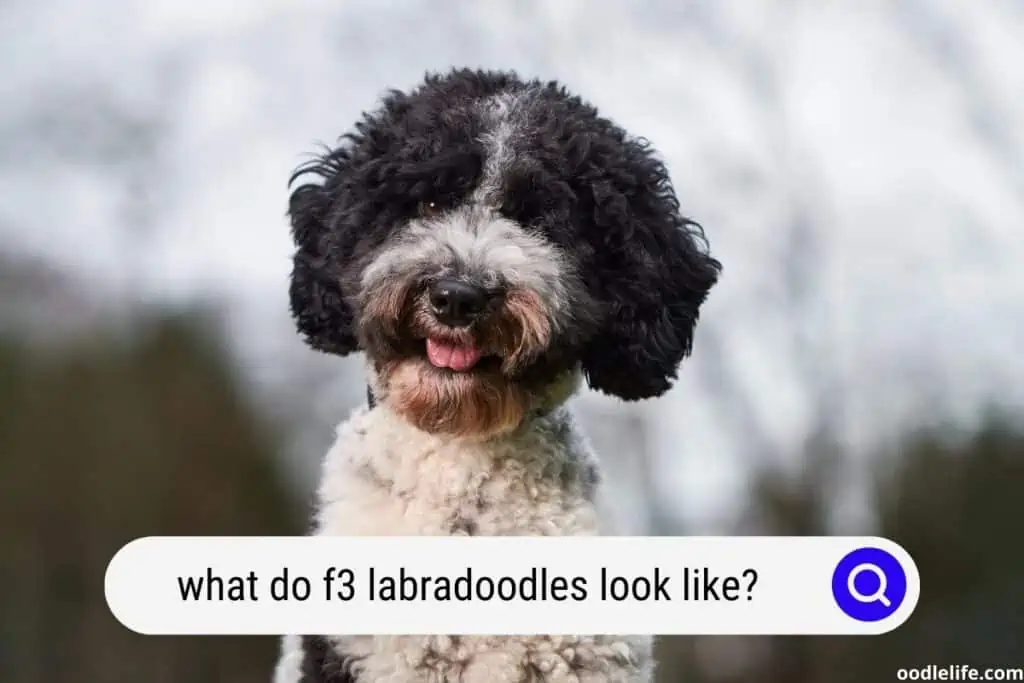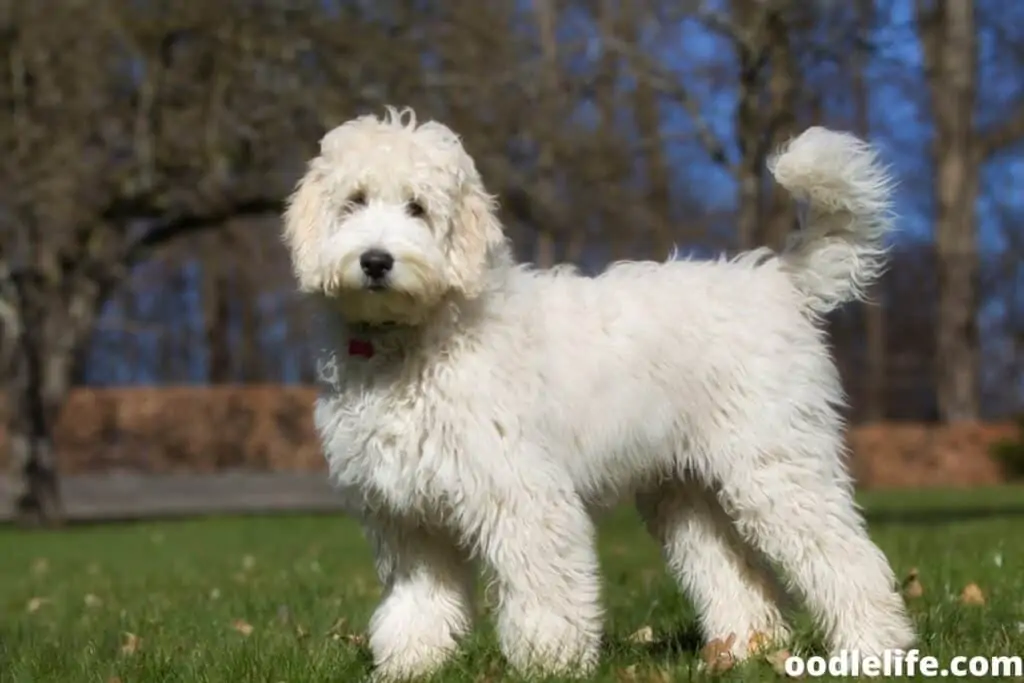F3 Labradoodle [Complete Guide] + Photos
Labradoodles are one of the most loved breeds in the world. They are a cross between a Labrador Retriever and a Poodle, which results in an intelligent, friendly, and easily trainable dog.
They are sweet-tempered, affectionate, and make great family pets. However, they do require some grooming and exercise, which is a small investment for the companionship they provide.

Labradoodle Generation Types
Labradoodles come in three different types: F1, F2, and F3. The kind of Labradoodle you choose will depend on your lifestyle and what you are looking for in a dog.
F3 Labradoodles are 50 percent Labrador and 50 percent Poodle. F3s are the result of breeding two second-generation Labradoodles. Today we will be discussing the F3 Labradoodle.

Meaning of F3 Labradoodle
We know that the Labradoodle is a mixed breed of a Labrador Retriever and Poodle. So, what does the F3 mean?

The “F” means “filial hybrid,” which means that the dog is a result of breeding two first-generation dogs from different parents. The 3 refers to the fact that this is the third generation of Labradoodle.
Let’s look at how we arrive at the F3 generation of Labradoodle.
The F1 Labradoodle combines the Labrador and Poodle. The result is a Labradoodle that is 50 percent Labrador and 50 percent Poodle.
The F2 Labradoodle is then bred with another F2 Labradoodle. The result will still be a Labradoodle that is 50 percent Labrador and 50 percent Poodle.
The F3 Labradoodle results from breeding two F2 Labradoodles, resulting in the same ratio (50 percent Labrador and 50 percent Poodle).
Let’s move on to discussing the F3 Labradoodle.

Size of an F3 Labradoodle
One thing to understand about generational breeding with two breeds is that the results are unpredictable at some level. With that being said, the size of an F3 Labradoodle will usually fall somewhere in between the size of its parent breeds.
There will be significant variations within each litter and from one litter to the next. The size of an F3 Labradoodle will also depend on other factors such as nutrition and exercise.
The average weight of an F3 Labradoodle is between 50 and 65 pounds. The average height is between 20 and 26 inches.
Of course, some dogs are on the smaller or larger side, but this is a general range that you can expect.

Coat Types
Most F3 Labradoodles have loose curls or extremely curly coats. The coils can range from tight ringlets to looser waves. The coat may be wavy or curly, but it is never straight.
Regardless of curl pattern, most breeds are hypoallergenic.
The coat of an F3 Labradoodle can be any color or combination of colors. Standard F3 colors are cream, black, brown, apricot, red, silver, and white.
The coat of an F3 Labradoodle will require some grooming. Their coats should be brushed several times a week to prevent matting and tangles. They will also need to be trimmed or clipped every few months.
It is important to note that Labradoodles do shed, but they are considered low-shedding dogs. This means that they will shed less than other breeds of dogs.

Temperament
F3 Labradoodles are intelligent, friendly, and easily trainable. They can even be used as service dogs or therapy dogs because of their temperament.
They are also known to be good with children and other animals. F3 Labradoodles need to be socialized at an early age.
This means exposing them to different people, places, and situations to lower their chances of being fearful or anxious in new situations. It will help to ensure that they grow up to be well-rounded dogs.

Training
F3 Labradoodles are intelligent dogs, and they are effortless to train. They are eager to please their owners and love to learn new things.
Like all dogs, F3 Labradoodles must be trained on basic obedience commands such as sit, stay, come, down, and heel.
They will also need to be taught not to jump up on people or furniture. In addition to obedience training, F3 Labradoodles will need to be socialized.

Health
F3 Labradoodles have a combination of the health problems that Poodles and Labrador Retrievers have.
The most common health problems seen in F3 Labradoodles are hip and elbow dysplasia, eye problems, and von Willebrand’s disease.
Hip and elbow dysplasia are hereditary conditions that cause the joint to develop abnormally. It can lead to pain, lameness, and arthritis.
Eye problems can include cataracts, glaucoma, and progressive retinal atrophy. von Willebrand’s disease is a blood clotting disorder that can lead to excessive bleeding.
All of these conditions can be diagnosed by your veterinarian.

Is It Better to Get an F3 Labradoodle Than Any Other Generation?
The great thing about getting an F3 Labradoodle is that they tend to be more hypoallergenic than other generations. It is not entirely understood why they tend to have more Poodle genetics.
If you are looking for a less likely dog to trigger your allergies, an F3 Labradoodle is a good choice.

Do Genetics Matter?
Genetics matter when it comes down to personal preference. Some people prefer the look of an F1 Labradoodle, while others prefer the coat type of an F3 Labradoodle.
It is really up to you which generation you prefer. The most important thing is finding a reputable breeder who is breeding healthy dogs.
No matter which generation you choose, do your research before you bring a new dog home. It is just another step to get you closer to the perfect Labradoodle for you and your family.

F3 Labradoodle Popularity
The F3 generation of Labradoodles is very popular. This harps further on the importance of doing research on breeders to avoid scams.
With the popularity of these dogs, there are bound to be some people who are looking to make a quick buck off of unsuspecting buyers.
Be sure to visit the breeder’s facility and meet the puppy’s parents you are interested in. It will help you get a better feel for the breeder and their operation.
Also, ensure they have the family tree or pedigree of the puppy you are interested in. This will help you see the health clearances of the parents and grandparents of the puppy.

Wrapping Up
The F3 Labradoodle is a third-generation mix between a Labrador Retriever and a Poodle. They are intelligent, easy to train, and make great family pets. F3 Labradoodles are the most hypoallergenic, which makes them a good choice for people with allergies.
When choosing an F3 Labradoodle, do your research on the breeder and get a copy of the family tree or pedigree. Taking all this into account will help you find the perfect F3 Labradoodle for your family.